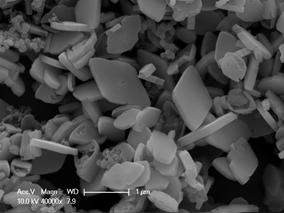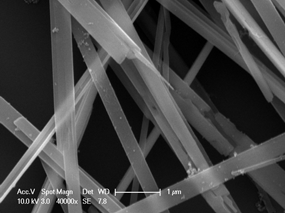Process to Synthesize Size Controlled Nanocrystalline Materials for Battery Electrodes
Background
Lithium Iron Phosphate (LFP) is an excellent cathode for lithium-ion batteries because of its thermal and chemical stability, low cost, good cycle stability and low toxicity. LFP is hindered by lower rate capacity because of its poor electronic conductivity and lithium-ion diffusivity. Typical methods used to produce LFP particles result in heterogeneities that act as stress concentrators resulting in lower battery life.
Brief Description
Researchers at UCR have developed a scalable and affordable process for synthesizing nanostructure materials like LiFePO4 (LFP) at low temperatures (150 to 200 oC) with highly reproducible sizes and morphologies. The nanocrystalline structures may be utilized as active elements in battery cathodes or anodes to enhance charging cycle stability or enhance capacitance (including when doped with conductive metals).
The process is performed at relatively low temperatures, and uses environmentally friendly solvents. This results in lower up front and ongoing manufacturing costs in cathode and anode production. The particle size and shape, as well as crystal orientation of the produced structures can be controlled, not only preventing loss of performance and capacity due to increased stresses and charge de-stabilization, but also improving rate capability. The nanostructures created with this method will result in increased battery power and energy density.

Fig. 1: Reproducible nanoprism crystal morphologies produced via the method described here.

Fig. 2: Reproducible nanobelt crystal morphologies produced via the method described here.
Advantages
- Controlled particle size and shape, as well as crystal orientation of the produced structures.
- Prevention of loss of performance and capacity due to lower stresses and charge de-stabilization, as well as improved rate capability.
- The process is performed at relatively low temperatures and uses environmentally friendly solvents.
- Lower up front and ongoing manufacturing costs in cathode and anode production.
- The nanostructures created with this method will result in increased battery power and energy density.
Suggested uses
This low cost, low temperature and environmentally-friendly process may be used in the scalable manufacture of active materials for batteries, including both cathodes and anodes. These nanomaterials have use in batteries for renewable energy and power grid storage applications.
Patent Status
| Country | Type | Number | Dated | Case |
| United States Of America | Issued Patent | 9,586,822 | 03/07/2017 | 2012-116 |
Inventions by Prof. David Kisailus
Please see all inventions by Prof. David Kisailus and his team at UCR
Related Materials
Contact
- Venkata S. Krishnamurty
- venkata.krishnamurty@ucr.edu
- tel: View Phone Number.
Other Information
Keywords
lithium ion, low temperature, electrode, anode, cathode, precision, energy, storage, LFP, battery, renewable, LiFePO4
